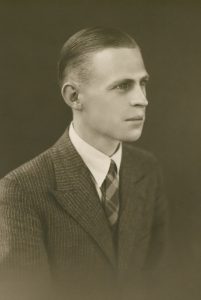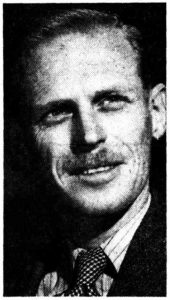
Rex Ingamells was born in Orroroo, South Australia, on 19 January 1913. His father was Eric Marfleet Ingamells, a minister with the Methodist Church, and his mother was Mabel Gwendolen (née Fraser).
He graduated with a Batchelor of Arts degree in 1934, and afterwards worked as a teacher at various educational institutions in South Australia in the 1930s and 1940s. He married Eileen Eva Spensley on 9 July 1938, at the Methodist Church in Port Broughton (SA).[1]
Rex was an aficionado of poetry. He was the winner of the Bundey Prize for English verse in 1935 (awarded by the Council of the University of Adelaide for six sonnets entitled “Forgotten People”). Twelve volumes of his verse were published in his lifetime (his first book of poetry, Gumtops, was printed in 1936).[2]
He credited Professor L. F. Giblin, Edward Garnett, and John Masefield with encouraging him to write poems about Australian nature; this was, perhaps, his first step towards the development of a philosophy of Australianism in literature.[3]
Ingamells noticed the “cultural cringe” that affected parts of Australian society in the early twentieth century, which favoured English cultural content and style; in response he founded the Jindyworobak cultural movement to foster Australian literature and promote Australianism (nativist cultural nationalism).
Rex Ingamells’ decision to create the Jindyworobak movement was influenced by L. F. Giblin’s foreword to Gumtops (1935) in which Giblin declared that there was a need for literary “pioneers”, who would forget about foreign influences and “try to give us their first-hand, direct reaction to nature and man as they find them in Australia”. He took Giblin’s idea and built upon it to create his theory of “environmental values” in literature.[4]
His outlook was further shaped by P. R. Stephensen’s essay published in The Australian Mercury (July 1935), which was, in essence, a call for Australian cultural nationalism; that article was the first installment of what was to become P. R. Stephensen’s book The Foundations of Culture in Australia: An Essay towards National Self-Respect (1936), which bore the same title as the original essay (Ingamells later mentioned that he didn’t see the book until 1941, when he was shown a copy by Ian Mudie). It is worth noting, as an aside, that Gumtops, including Giblin’s foreword, had been sent to P. R. Stephensen’s publishing firm in 1934, but that Stephensen had regretfully declined to publish it.[5]
Interestingly, Ingamells has also cited two other key influences, both coming from outside of white Australian culture. The first was Kangaroo (1923), by the English author D. H. Lawrence, from which Rex had “gained a strong sense of the primaeval in Australian nature”, although he “rejected Lawrence’s view of strangeness in the Spirit of the Place”. Ingamells had learnt of Lawrence’s book from references to it in The Australian Mercury. The second was The Vanished Tribes (1929), by James Devaney, which Rex discovered in 1936. Devaney’s book dovetailed with Ingamells’ travels in Central Australia in 1930-1931, which was the foundation of his interest in the Aborigines. It was from that publication that Rex took the name “Jindyworobak” (a slight adaptation of “Jindy-worabak”), an Aboriginal word meaning “to join”, the usage of which was explained in the first Jindyworobak anthology thus: “Here it suggests an attempt to direct Australian poets to what should be their distinctive materials.” One tactic that Rex Ingamells and some other Jindy authors used to connect their writings with Australian themes was to use Aboriginal words and imagery in their literature (on occasion too much so, even to the point of incomprehension by ordinary readers).[6]
To explain his views on cultural Australianism, Rex Ingamells produced two key pieces of writing. In 1937 he wrote an essay called “Concerning environmental values”, which was based upon a public lecture he had given to the English Association in Adelaide earlier that year; it was published in Venture: An Australian Literary Quarterly (July 1937; edited by Ingamells). Then, the following year, he authored a booklet entitled Conditional Culture; his “Environmental values” essay was included in the booklet as Section II. In the Jindyworobak Anthology, 1944, he referred to Conditional Culture and Flaunted Banners (by Victor Kennedy) as “pamphlets upon which this movement has been built”.[7]
The Jindyworobak Anthology was an annual collection of Australian poetry published by Ingamells from 1938 to 1953; he edited the collection for 1938-1941 and 1947 (the tenth anniversary issue), but for the other years the anthology was compiled by guest editors. In the 1938 issue, Rex explained that “my main purpose in editing this anthology has been to stress something of the possibilities of poetry based on the Australian environment”. In the 1939 edition, he said that he was “convinced that the value to be gained from a pure and realistic sense of national direction in literature is of immense importance.”[8]
In 1945 he moved to Melbourne, where he was employed as a publisher’s representative, after which he took on work as a commercial traveller (company representative or salesman) for book publishers (with his teaching background, he had the gravitas to sell educational publications).

Rex Ingamells died in a car accident near Dimboola, Victoria, on 30 December 1955. He was buried in Payneham cemetery, Adelaide.[10]
The work of Rex Ingamells and the Jindyworobak movement contributed to the rise of cultural nationalism in Australia, thereby encouraging Australians to value homegrown literature and art, to dismiss the cultural cringe, and to value cultural Australianism. At a time when British, European, and (sometimes) American works were often rated higher than local cultural output, Rex Ingamells and the Jindyworobaks helped Australians to gain a sense of their own cultural worth.
Books and booklets by Rex Ingamells:
1935: Gumtops (poetry)
1936: Forgotten People (poetry)
1938: Conditional Culture (with Ian Tilbrook) (non-fiction)
1938: Sun-Freedom (poetry)
1940: Memory of Hills (poetry)
1941: At a Boundary: Verses (with John Ingamells) (poetry)
1942: News of the Sun (poetry)
1943: Content are the Quiet Ranges (poetry)
1943: Unknown Land (poetry)
1944: Selected Poems (poetry)
1945: Yera: A Verse Narrative (poetry)
1948: Come Walkabout (poetry)
1949: From Phillip to McKell: The Story of Australia (non-fiction)
1949: Handbook of Australian Literature (non-fiction)
1951: Because Men Went Hungry: An Essay on the Uncertainty of Australian Prestige (non-fiction)
1951: The Dunce’s Cap: A Critical Essay in Self-Defence (pamphlet) (non-fiction)
1951: The Great South Land: An Epic Poem (poetry)
1952: Of Us Now Living: A Novel of Australia (fiction)
1952: William Gay: Australian Man of Letters (non-fiction)
1952: Aranda Boy: An Aboriginal Story (fiction)
1954: Royalty and Australia (non-fiction)
1955: Australian Aboriginal Words: Aboriginal-English, English-Aboriginal (non-fiction)
1987: Platypus and Kookaburra: Poem (children’s picture book; posthumously published) (poetry)
Publications edited by Rex Ingamells:
1937: Venture: An Australian Literary Quarterly (only one issue published, July 1937, edited by Rex Ingamells)
1938-1953: Jindyworobak Anthology (an annual publication, 1938-1953, overseen by Rex Ingamells as editor or editor-in-chief, as he arranged for some issues to be edited by others)
1939-1940: Venture: Jindyworobak Quarterly Pamphlet (a quarterly publication, edited by Rex Ingamells)
1943: New Song in an Old Land: Australian Verse (edited by Rex Ingamells; republished several times in later years)
1945: Garchooka: A Magazine for Australian Boys (edited by Rex Ingamells)
1948: Jindyworobak Review, 1938-1948 (edited by an editorial committee, headed by Rex Ingamells)
1948: Spoils of Time: Some Poems of the English-Speaking Peoples (edited by Rex Ingamells)
1953: Merringek: For an Understanding of Australia’s History and Traditions, Primeval, Colonial and Modern (only one issue published, 1953, edited by Rex Ingamells)
Selected articles by Rex Ingamells:
Concerning environmental values [July 1937]
Editorial [April 1939]
Australianism [1941]
How S.A. man wrote 8,500-line poem [21 March 1951]
Selected poetry by Rex Ingamells:
[in addition to the books listed above]
Garchooka, the Cockatoo [July 1937]
Outback [1938]
References:
[1] John Dally, “Ingamells, Reginald Charles (Rex) (1913–1955)”, Australian Dictionary of Biography, National Centre of Biography, Australian National University
“Rex Ingamells bio”, My Poetic Side
[2] “Personal”, The Advertiser, (Adelaide, SA), 1 June 1935, p. 18
“News of the week at home”, The Chronicle, (Adelaide, SA), 6 June 1935, p. 40
[3] Rex Ingamells, “Introduction”, in: Rex Ingamells (editor) et al, Jindyworobak Review, 1938-1948, Melbourne: Jindyworobak, 1948, p. 9
[4] Rex Ingamells, “Introduction”, op. cit., 1948, p. 10
[5] Rex Ingamells, “Introduction”, op. cit., 1948, pp. 10-11, 19
[6] Rex Ingamells, “Editor’s note”, in: Rex Ingamells (editor), Jindyworobak Anthology, 1938, Adelaide: F. W. Preece, [1938], p. 3
Rex Ingamells, “Introduction”, op. cit., 1948, pp. 10-11
[7] Rex Ingamells, “Note”, in: W. Hart-Smith (editor), Jindyworobak Anthology, 1944, Melbourne: Georgian House, 1944, p. 2
Rex Ingamells, “Jindyworobak”, in: Gina Ballantyne (editor), Jindyworobak Anthology, 1945, Melbourne: Georgian House, 1945, p. 63
[8] Rex Ingamells, “Editor’s note”, op. cit., [1938], p. 3
[9] “Literary Fellowships”, The Daily Examiner (Grafton, NSW), 23 October 1948, p. 3
“Crouch Prize for Literature to R. Ingamells”, The Age (Melbourne, Vic.), 7 April 1952, p. 5
“Book awards: Grace Leven Prize for Poetry”, LibraryThing
[10] John Dally, op. cit.
Further information:
“Rex Ingamells”, Wikipedia
“Jindyworobak Movement”, Wikipedia
Leave a Reply